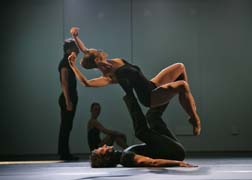
Jack Anderson
Luca Veggetti and the Cincinnati Ballet
Works & Process, Guggenheim Museum, 1071 Fifth Avenue, Upper East
Side
March 25 and 26, 2007 (closed)
Information: (242) 423-3587
Reviewed by Jack Anderson, March 27, 2007
The enterprising Works & Process programs in the intimate Peter B. Lewis Theater of the Guggenheim Museum give audiences peeks into works-in-progress and accompany these performances with relevant lectures and discussions.
 |
| Left to right: Cervilio Miguel Amador, Janessa Touchet, Dmitri Trubchanov & Kristi Capps of The Cincinnatti Ballet. Photo by Richard Termine. |
The Cincinnati Ballet's visit to New York offered glimpses of dances by Luca Veggetti, an Italian choreographer little-known here, who contributed three small-scale ballets to scores for solo instruments by the Japanese composer Toshio Hosokawa. Victoria Morgan, the company's artistic director, has encouraged Veggetti in recent seasons, and his ballets pique curiosity with their juxtapositions of propulsion and restraint.
"On the Edge of Silence," to alternately fluttery and sustained flute tones, for which Justin Bahrami was the soloist, featured all five of the evening's performers: Kristi Capps, Janessa Touchet, Dmitri Trubchanov, Cervilio Miguel Amador, and R. Colby Damon, a guest from the Sacramento Ballet. Dancers began with whipping movements through space while waving poles that made whooshing sounds in the air. The dancing that followed contrasted speed and stillness.
In "Night/Sounds" two dancers interrupted sudden hurtlings with pauses in which they seemed to be suspended in time while Daniel Spiegel played a piano score filled with its own stops and starts.
Four dancers in "Traces" posed like boulders in a Japanese rock garden, then scattered off, only to regroup moments later to rumbling accordion music performed by Viviane Chassot. Deliberately blurry projections in "Night/Sounds" and "Traces" were unnecessary distractions from the lucid choreography.
During two panel discussions (the first ponderous, the second succinct), Veggetti said that he has been greatly influenced by Japanese Noh theater and, even though there were no obvious imitations of Noh, his spare little dances had some of the formal meticulousness associated with that style. The three pieces also had an overall sameness of choreographic texture. But since they seemed to form a triptych, that may have been intentional. Fortunately, Veggetti's sense of sculptural mass and fleet linear patterning make me interested to see more ballets by him.
New York should certainly see more of the Cincinnati Ballet
which, under Morgan's direction, has built an eclectic repertoire of popular
favorites, new works by various choreographers, and unusual revivals,
including variations from Frederick Ashton's exquisite, but now almost
entirely lost, "Devil's Holiday" and the three surviving movements
(out of four) from Léonide Massine's mighty "Seventh Symphony"
which, fortunately, constitute a coherent theatrical whole.
| museums | NYTW mail | recordings | coupons | publications | classified |
